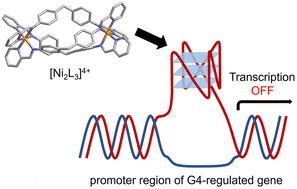Dinuclear nickel(ii) supramolecular helicates down-regulate gene expression in human cells by stabilizing DNA G-quadruplexes formed in the promoter regions†
Abstract
We investigated the interaction of the M- and P-enantiomers of the dinuclear nickel(II) tetracationic supramolecular helicate ([Ni2L3]4+, L = C25H20N4) with a series of four DNA G-quadruplexes (G4s) (hTelo, c-myc, c-kit1, c-kit2) formed by the human telomeric sequence (hTelo) and in the promoter regions of c-MYC and c-KIT oncogenes. Utilizing a multi-platform approach based on biochemical and molecular biophysics methods to study these interactions, we show that [Ni2L3]4+ helicates preferably bind to G4s over duplex DNA and that their binding selectivities towards DNA G4 structures are comparable to those of renowned G4 binders. Additionally, primer extension studies on DNA templates containing G4-forming sequences proved that stabilization of hTelo and particularly c-myc G4s by the nickel(II) helicates was sufficient to cause premature termination of DNA synthesis catalyzed by Taq DNA polymerase. We also confirmed that nickel helicates are taken up by human embryonic kidney (HEK 293) cells and enter the nucleus, where they bind to DNA. Results from qRT-PCR and western blotting demonstrated that [Ni2L3]4+ helicates downregulate c-MYC expression at mRNA and protein levels in HEK 293 cells in a dose-dependent manner.



 Please wait while we load your content...
Please wait while we load your content...